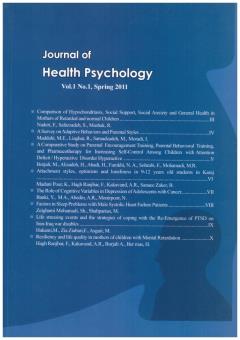Attachment styles, optimism and loneliness in 9-12 years old students in Karaj. Authors: (Kobra Mandaripour / Farrokh Haq Ranjbar / Alireza Kakavand / Baqher Sanai Zaker)
Subject Areas : Psychology of wellbeing
Keywords: attachment styles, optimism, loneliness.,
Abstract :
Abstract
In this study, the researcher scrutinized the relationship among attachment styles, optimism and loneliness in 9-12 year old students in Karaj. The approach used for the research was post expository. Sampls included 200 students (100 males and 100 females) who were selected randomly to study their attachment styles using Ronaghi attachment style scale (1387), and Peterson et al. attributional styles (ASQ) scales. A questionnaire to measure loneliness and Asher et al variance analysis scale was utilized too. Data were analyzed by the following methods of Descriptive (M, SD) and deductive methods (Pearson’s coefficient correlation and multivariate analysis of variance - MANOVA). Results showed that there was a significant relation among optimism, loneliness and attachment styles which depicted a very omnipotent factor for child upbringing and future life. Both above-mentioned approaches played an influential role and they altered into a comprehensive introvert factor inside child s personality.
منابع
1. دلاور. ع. (1388). مباني نظريه و عملي پژوهش در علوم انساني و اجتماعي، تهران. انتشارات رشد.
2. نوري، ن. ا. (1385) نقش خوشبيني در كاهش اضطراب، مجله راه تربيت، شماره 3، مركز جهاني، معاونت فرهنگي.
Asher, S.R. (1985). Childrens loneliness: A comparison of Rejected and neglaected peer status, journal of consulting and clinical psychology, 35 (4), 500-505.
Bartholomew, K., & horowitz, L. (1991). Attachment styles among young adults: a test of a four- category mode. Journal of personality and social psychology, 61, 226-244.
Belsky, J., & Cassidy, J. (1994) Attachment: Theory and evidence. In M.Rutter, D. Hag, & S.K. Baron- cohen (Eds.) Developmental Orinciples and clinical issues in psychology and psychiatry. Oaford: Black well, science publishers.
Bowlby, J. (1969). Attachment and loss: Vol. I. Attachment. New York: Basis books.
Bowlby, J. (1988). A. secure Base: clinical Applications of Attachment Theory. New York. Basic books.
Bretherton, I. (1985). Attachment theory: Retrospent and prospect. In i. retherton & E. waters (Eds.), growing points of attachment theory and research, monographs of the society for research in child Development, 50, 3-35.
Cassidy, J., & asher, S.R. (1992). Loneliness and peer relations in young children. Child development, 36, 350-365.
Fagot, B.I. (1995). Parenting boys and girls. In M.H. Bornstein (Ed.) Handbook of parenting (vol, 1, 163-183). Mahwahnj: Erlbaum.
Gergely, g., & Watson, K. S. (1996). The social biofeedback theory of parental affect- mirroring: the development of emotional self- awareness and self- control in infancy. International Journal of Psychoanalysis, 77, 1-31.
Golbberg, S. (1991). Recents development in attachment theory and research. Canadian Journal of psychiatry, 36, 393-400.
Hojat, M. (1996). Perception of mental avaitability in child hood and selected psychosocial characteristic in adthood. Gentic social and general psychology monographs. 122, 425-450.
Hojat, M. (1998). Satisfaction with early relationships with parents and psychosocial attributes in adulthood: which parent contributes more? The journal of genetic psychology, 159, 203-220.
movstakas, C.E. (1990). Loneliness, new jersey: prentice- Hall
Parke, K.A., & waters, E. (1989). Security of attachment and preschool friendships. Child Development, 60.1076-1082.
Peplau, L.A. & perlam, D. (eds). (1982). Lone liness: a sourcebbok of cureent theory, research and therapy. New York. NY: university press.
Ponzetti, J.J., & Hopmeyer, A. (1999). Loneliness among college student. Family relations, july, 336-340.
Rothbard, J.C., & shaver, P.R. (1994). Continuity of affachment acroos the life span. In M.B. sperling, & W.H. Berman (Eds.), Attachment in adults: Clinical and Developmental Perspective. New York, london: the Guilford Press.
Shaver, P. B freeman, J. (1976). Your pursuit of happiness. Psychology today, 10 (3), 26-32.
Sullivan. H.S. (1953). The inter personal theory psychiatry, new York: Norton.
Tennant, C. (1988). Parental loss in childhodd: It,s effect in adult life. Archives of General Psychiatry, 45, 1045-1050.
Waters, E. Merrick, S., Treboux, D., Crowell, J., & Albersheim,, L. (2000). Attachment security in infancy and early adulthood: a twenty- year longitudinal study. Child Development, 3, 684-689.
Weiss, R.S. (1973). Loneliness: the experience of Emotional and social isolation. Cambrige, MA: mit press.

